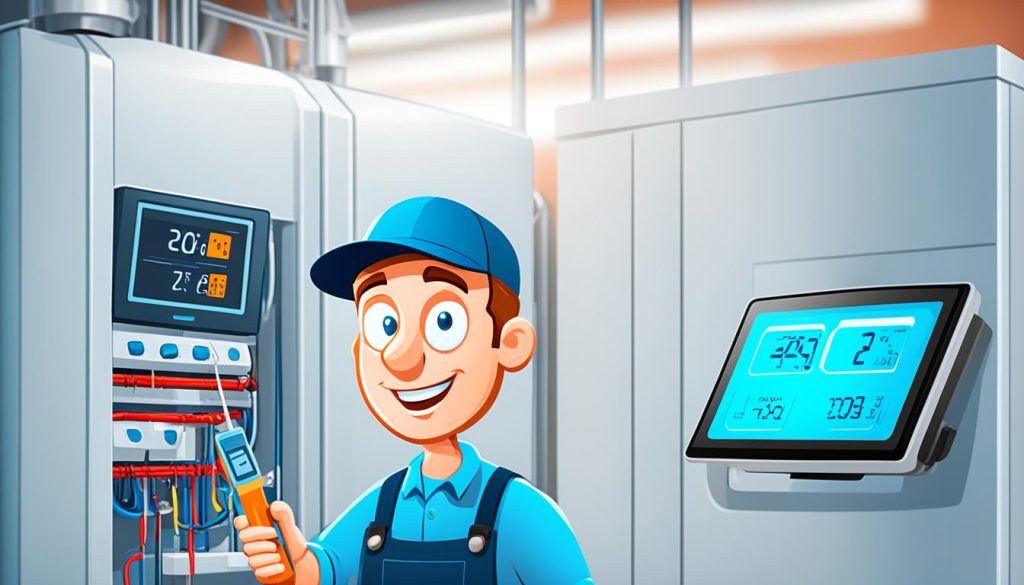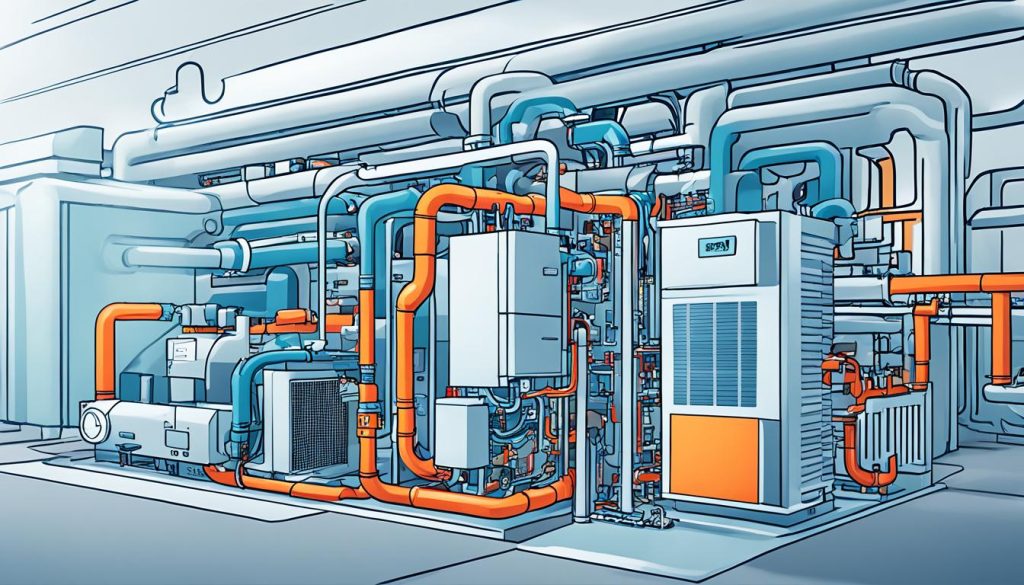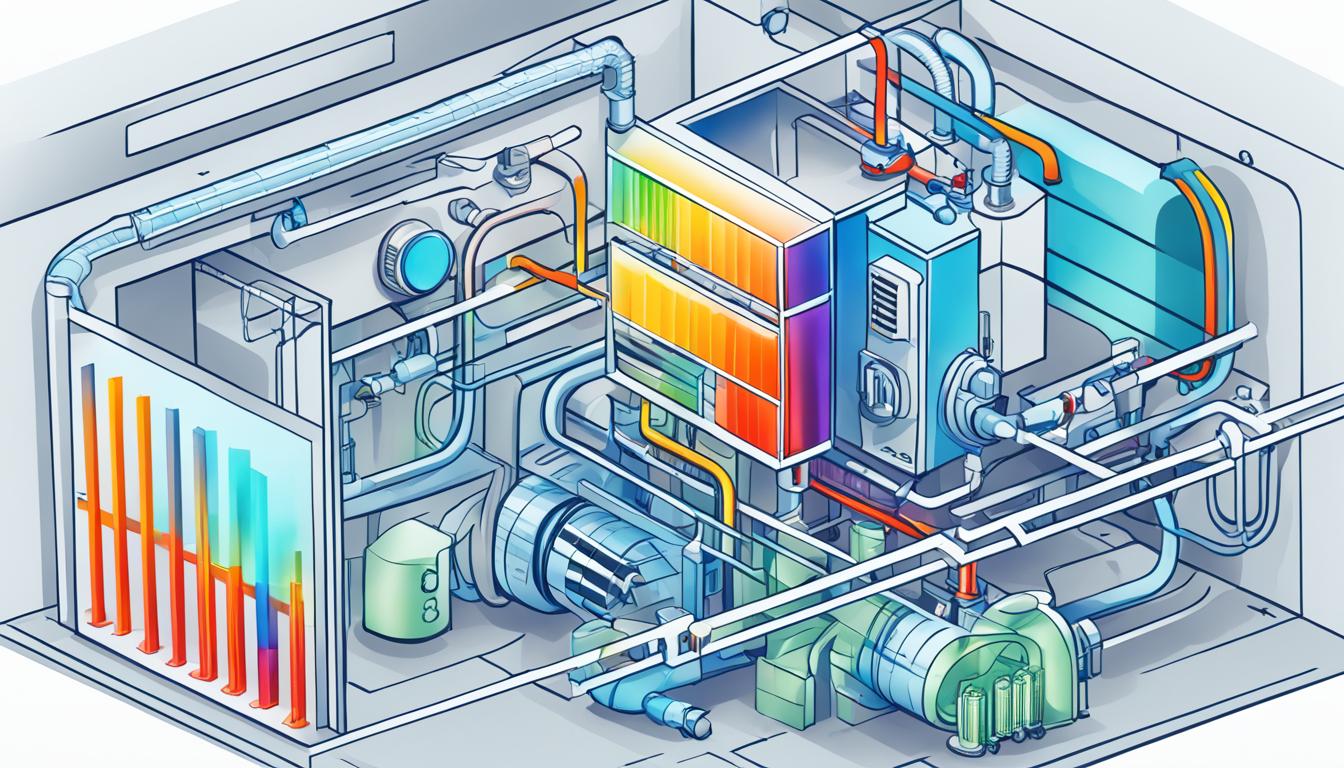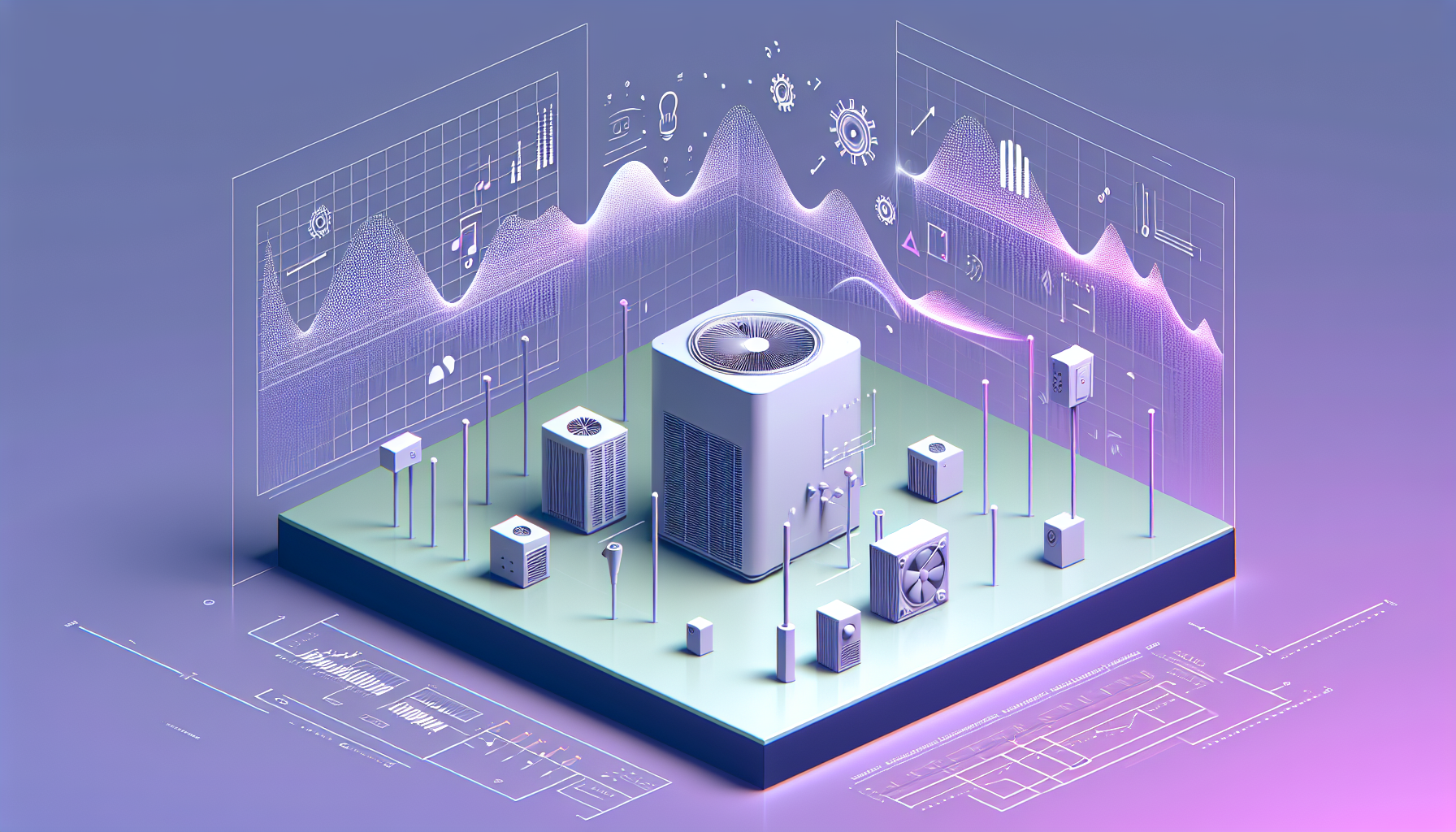You can use heat load calculation software to make your HVAC systems better. This method helps you save energy, cut costs, and avoid equipment failures. It’s all about using advanced analytics with your HVAC systems.
Heat load calculation software gives you important insights into how your system works. By looking at this data, you can plan maintenance ahead. This means your HVAC equipment will run better. It combines IoT sensors, machine learning, and heat load calculations for better efficiency.
Using predictive maintenance with heat load data changes the game for managing industrial assets. It helps you see problems before they happen, plan repairs when it’s best, and make your HVAC equipment last longer. By using HVAC analytics, you move from fixing problems after they happen to preventing them before they start. This leads to big savings and more reliable systems.
Understanding Predictive Maintenance in HVAC Systems
Predictive maintenance changes the game for HVAC systems by using data to stop equipment failures before they happen. This method boosts system performance and cuts down on costs.
Definition and Importance of Predictive Maintenance
Predictive maintenance uses advanced analytics to predict when HVAC equipment might fail. It looks at performance data to stop sudden breakdowns and fine-tune maintenance plans. This smart approach is key to keeping HVAC systems running well and efficiently.
Role of Heat Load Calculation Software in HVAC Analytics
Heat load calculation software is a big deal in HVAC analytics. It handles data on system performance, energy use, and environmental factors. This software spots patterns and potential problems, helping with predictive maintenance plans that keep HVAC systems at their best.
Benefits of Implementing Predictive Maintenance
Adding predictive maintenance to HVAC systems brings lots of perks:
- Less downtime and fewer surprise repairs
- Better energy use and lower bills
- Longer equipment life, meaning less need for replacements
- Improved system reliability and performance
- Smarter use of maintenance resources
| Aspect | Traditional Maintenance | Predictive Maintenance |
|---|---|---|
| Approach | Reactive or scheduled | Data-driven and proactive |
| Cost Efficiency | Higher long-term costs | Lower overall expenses |
| System Downtime | More frequent, unexpected | Minimized, planned |
| Energy Efficiency | Variable, often suboptimal | Consistently optimized |
| Equipment Lifespan | Shorter due to wear | Extended through timely care |
By using predictive analytics, HVAC systems get more reliable, efficient, and cost-effective. This method saves money and makes sure buildings stay comfortable all year.
The Fundamentals of Heat Load Calculation Software
Heat load calculation software is key in designing and optimizing HVAC systems. It uses advanced tech to figure out what buildings need for heating and cooling. It looks at things like building materials, how many people use the space, and the local weather to get accurate results.
This software is great at modeling energy use. It runs complex simulations to see how a building’s HVAC will work under different situations. This helps engineers pick the right equipment and design systems that work well, saving energy and keeping people comfortable.
The software pulls data from many places, such as:
- Building size and layout
- How well insulated it is
- Details about windows
- How often the building is used
- Weather in the area
With all this info, the software builds a detailed picture of how a building stays warm or cool. This model is key for predicting energy use, spotting problems, and making the system better.
Today’s heat load calculation software can use live data from sensors and building systems. This means it can make predictions that are more accurate and change as needed. This leads to big energy savings and better comfort inside buildings.
Implement Predictive Maintenance with Heat Load Data
Predictive maintenance is changing the game for HVAC systems. By using heat load data, you can make your equipment work better and avoid expensive repairs. Let’s dive into how to use this powerful method.
Integrating Heat Load Data
Getting data together is crucial for predictive maintenance. Mix past performance with current heat load figures. This blend helps you see trends and predict problems early. Use special software to look at energy use and temperature changes over time.
Key Metrics and Indicators
Pay attention to these important metrics from heat load data:
- Energy efficiency ratios
- Temperature stability indices
- Equipment runtime hours
- Cooling and heating load variations
These metrics show when maintenance is needed. This cuts down on unneeded repairs and makes equipment last longer.
Leveraging IoT Sensors
IoT sensors are a big deal for keeping an eye on things in real-time. Put these devices in your HVAC system to get data non-stop. They track temperature, humidity, and airflow, giving you a full picture of your system’s health.
| Sensor Type | Data Collected | Maintenance Insight |
|---|---|---|
| Temperature | Ambient and equipment temps | Overheating risks |
| Pressure | Air and refrigerant pressure | Leak detection |
| Vibration | Equipment vibration levels | Mechanical wear |
By using these methods, you’ll set up a strong predictive maintenance system. This approach boosts efficiency, cuts downtime, and lowers maintenance costs.
Data Collection and Analysis Techniques
Heat load calculation software is key in understanding HVAC systems. It collects and analyzes data to improve system performance and support predictive maintenance.
Types of Data Collected
This software collects many data points from HVAC systems:
- Temperature readings
- Humidity levels
- Airflow measurements
- Energy consumption metrics
- Equipment runtime hours

Data Analysis Methods
HVAC experts use different analysis techniques to get insights from the data:
- Statistical modeling
- Trend analysis
- Anomaly detection
- Performance benchmarking
These methods spot patterns and issues in system performance. This allows for quick fixes and improvements.
Machine Learning for Pattern Recognition
Advanced pattern recognition uses machine learning to better understand HVAC data. These algorithms include:
| Algorithm | Application |
|---|---|
| Neural Networks | Predict energy consumption patterns |
| Decision Trees | Classify system faults |
| Support Vector Machines | Detect anomalies in equipment performance |
| Random Forests | Forecast maintenance needs |
Using these advanced data analysis and machine learning methods, you can fully tap into your HVAC system’s data. This leads to better efficiency and proactive maintenance.
Developing Predictive Models Using Heat Load Data
Predictive modeling is key to data-driven HVAC maintenance. By using heat load data, you can make forecasting tools that guess system behavior and issues. This changes how we predict HVAC performance, making maintenance proactive.
To make good predictive models, you need to look at past performance, current conditions, and the environment. This helps make accurate predictions of system behavior and possible failures.
Key Techniques in Predictive Modeling
- Regression Analysis: Finds relationships between variables
- Time Series Forecasting: Uses past data to predict future trends
- Machine Learning Algorithms: Finds complex patterns in big datasets
These methods together create strong predictive models for HVAC systems. Using these models, you can make your system work better, cut downtime, and make equipment last longer.
Benefits of Data-Driven Maintenance
Using predictive modeling in HVAC maintenance has many benefits:
- Early fault detection
- Less energy use
- Better occupant comfort
- Lower maintenance costs
- Longer equipment life
By using heat load data and advanced analytics, you can change your HVAC maintenance from reactive to proactive. This not only makes your system more reliable but also saves costs and boosts energy efficiency.
Integrating Predictive Maintenance into Existing HVAC Systems
Adding predictive maintenance to your HVAC systems can make them work better and cut down on downtime. This means going through a few important steps and thinking about a few things to make the switch easy.
Steps for Implementing Predictive Maintenance
To make predictive maintenance work, you should:
- Look at your current HVAC system
- Pick the right sensors and software
- Set up how to collect data
- Use tools to analyze data
- Make maintenance plans based on what the data shows

Overcoming Common Integration Challenges
Integrating HVAC systems can be tough. One big problem is making sure old systems work with new ones. It’s also key to have good data for predictive maintenance. To fix these problems, think about updating old parts and using strong checks to make sure data is right.
Training Staff on New Maintenance Protocols
Training your team is crucial for success. Focus on:
- Understanding data
- New ways of doing maintenance
- Using predictive analytics tools
Give your team practical training and support as they learn these new ways. Regular workshops can help keep them up-to-date with the latest in predictive maintenance and HVAC tech.
| Implementation Challenge | Solution |
|---|---|
| Legacy system compatibility | Gradual upgrades, use of adaptors |
| Data quality issues | Implement data validation processes |
| Staff resistance to change | Comprehensive training programs |
Case Studies: Successful Implementations of Predictive Maintenance
Predictive maintenance success stories show the strength of HVAC case studies in various industries. They prove how companies have changed their operations with data-driven choices.
A big office building in New York City used predictive maintenance with heat load calculation software. They looked at energy use and equipment performance patterns. This cut HVAC downtime by 35% and energy costs by 22% every year.
In Michigan, an automotive parts factory added IoT sensors to their HVAC systems. This let them spot equipment failures early, cutting unexpected breakdowns by 40% and boosting productivity by 15%.
Healthcare facilities have also seen the benefits of predictive maintenance. A hospital in California used thermal imaging and machine learning to check their HVAC. This led to better air quality and a 30% drop in maintenance costs.
| Industry | Improvement Area | Results |
|---|---|---|
| Commercial Real Estate | Energy Efficiency | 22% cost reduction |
| Manufacturing | Equipment Uptime | 40% fewer breakdowns |
| Healthcare | Air Quality & Maintenance | 30% cost savings |
These stories show the real benefits of using predictive maintenance in HVAC systems. By using data analytics and new tech, companies in different fields can see big gains in efficiency, cost cuts, and performance.
Advanced Techniques: Thermal Monitoring and Condition-Based Maintenance
New technologies are changing the game in HVAC maintenance. Thermal imaging and condition-based maintenance are leading the way. These methods let you find problems early, saving time and money.
Utilizing thermal imaging for equipment diagnostics
Thermal imaging is a key tool for checking equipment without opening it up. It shows heat patterns that are not visible to the human eye. With thermal cameras, you can spot overheating parts, electrical problems, and insulation issues fast and accurately.
Implementing condition-based maintenance strategies
Condition-based maintenance uses real-time data to know when maintenance is needed. It shifts from fixed schedules to the actual condition of your equipment. By tracking important factors, you can predict breakdowns and plan maintenance when it’s most needed. This saves resources.
Combining thermal data with other predictive maintenance techniques
Using thermal data with other predictive methods makes maintenance more thorough. Adding thermal imaging to vibration analysis, acoustic monitoring, and oil analysis boosts failure prediction accuracy. This mix leads to better maintenance planning and more reliable equipment.
| Technique | Benefits | Application in HVAC |
|---|---|---|
| Thermal Imaging | Detects heat anomalies, electrical issues | Compressors, motors, electrical panels |
| Vibration Analysis | Identifies mechanical problems | Fans, pumps, bearings |
| Acoustic Monitoring | Detects leaks, unusual noises | Ductwork, refrigerant lines |
| Oil Analysis | Assesses lubricant condition | Compressors, gearboxes |
The Future of Predictive Maintenance in HVAC: AI and Machine Learning
Artificial intelligence and machine learning are changing predictive maintenance in HVAC. These technologies are making HVAC systems smarter and more self-sufficient. They use past data to make smart choices without needing human help.
Self-learning algorithms are leading the way in predictive maintenance innovation. These programs can find problems before they turn into big issues. They look at how systems work and alert you to any odd behavior that could cause a breakdown. This way, you save money on repairs and keep your HVAC running well.
Smart building integration is another big step forward in HVAC maintenance. AI systems can talk to other building parts to use energy better and keep you comfortable. This teamwork makes sure your HVAC, lights, security, and other systems work together perfectly.
As AI gets better, HVAC systems will be able to fix their own problems. This automation means less downtime and longer equipment life. The future of HVAC maintenance is all about being smart, efficient, and easy, thanks to AI and machine learning.





0 Comments